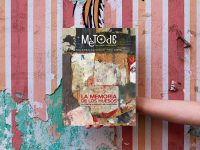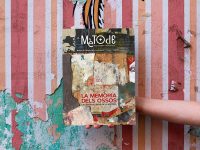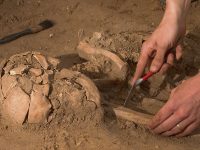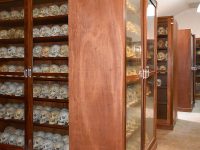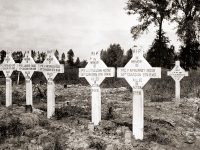The case of the brains of La Pedraja
Forensic sciences and historical memory in Spain
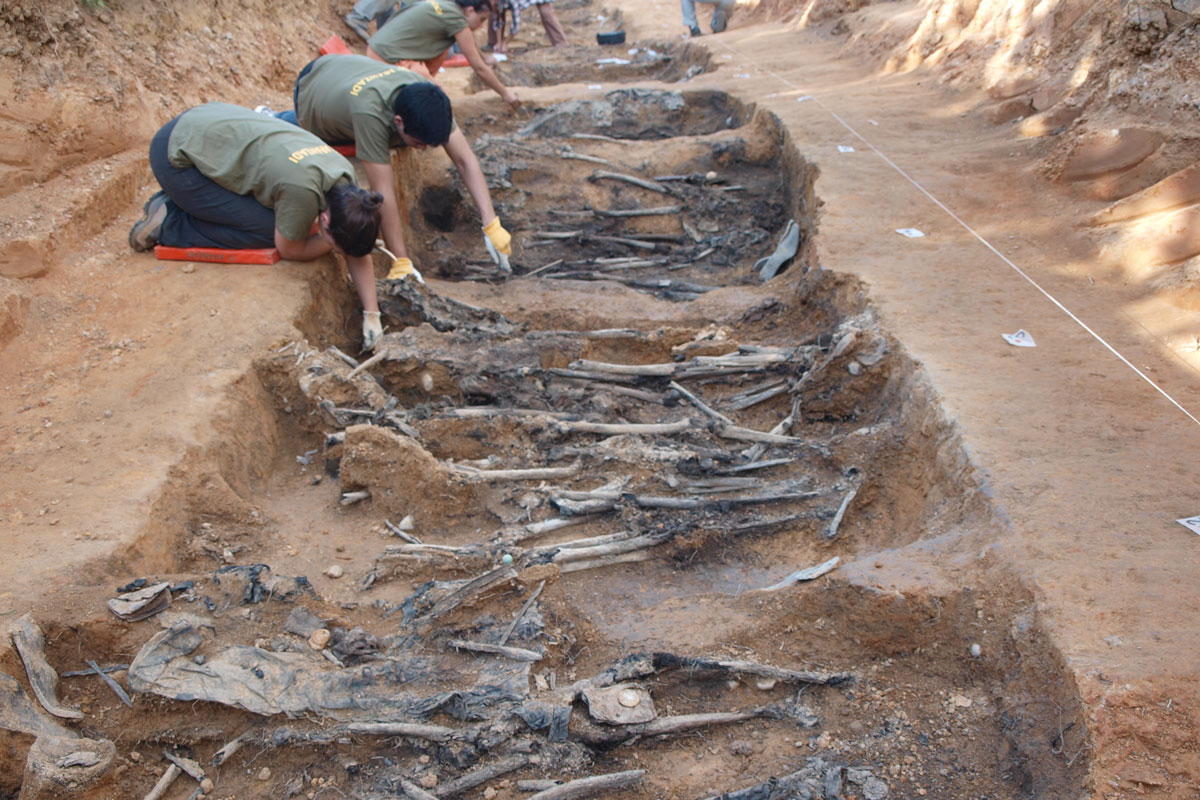
Here we present the key elements of forensic intervention as a method to obtain formal evidence for use in historical memory claims made in Spain since the year 2000, all within a general human rights framework. There are enough human and material resources to meet this social demand, but collaboration with all the necessary public administrations is also required. As an example, here we present the unusual phenomenon of brain preservation at the mass grave of La Pedraja. The study of these brains broadened our knowledge of the potential existence of ante-mortem injuries and is a way to deepen forensic investigation some 80 years after the original events occurred.
Keywords: forensic medicine, forensic anthropology, criminology, human rights, historical memory.
Introduction
The development of forensic science has now exceeded its traditional application in the field of penal justice and is also used in other spaces such as human rights and humanitarian law. There are countless examples from all over the world, mainly of its application to transitional justice in countries where human rights violations have been committed. A good example of this is the mission developed by the International Committee of the Red Cross (ICRC) in the Falkland-Malvinas islands in 2017 at the request of the Argentinian and United Kingdom governments.1 In the search for the truth, forensic medicine has now become essential for managing evidence which can become incontestable after its administrative validation.
Thus, in matters of missing persons and mass graves, the key objective is to establish the identity of the victim and the date of death, determine the medical cause of death, interpret its medical and legal aetiology (suicide, accident, or homicide), and provide information about the circumstances surrounding the death. This is the goal in contemporary cases around the world and the same methodology can be applied to more ancient cases as well as twentieth-century instances such as Spanish cases related to historical memory. In these cases, institutional forensic intervention ensures reliability in terms of the collection of forensic evidence and can also attend to the depositions and documentary evidence which can establish official truths.
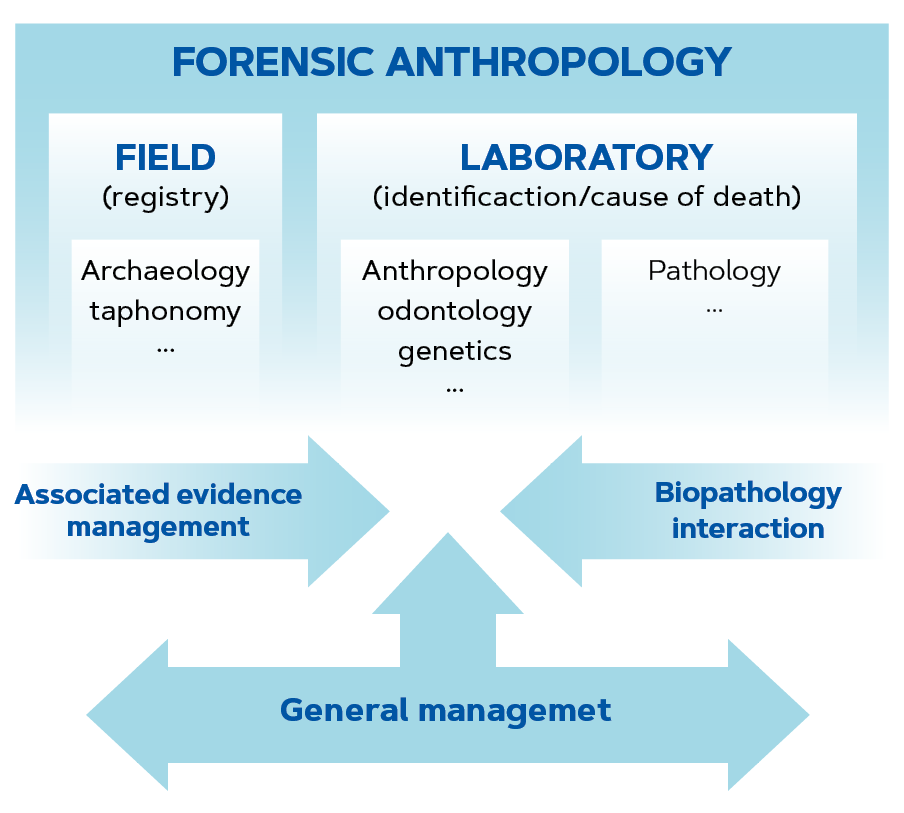
Figure 1. Outline of the integrative approach which now characterises forensic anthropology. In matters of missing persons and mass graves, the key objective is to establish the identity of the victim and their date of death, determine the medical cause of death, interpret its medical and legal aetiology, and provide information about the circumstances surrounding the death.
The methodological aspects developed in the four areas of specialisation concerned – forensic archaeology, forensic anthropology, forensic pathology, and forensic genetics – have extensive supporting literature and use internationally recognised standards (ICRC & Instituto de Medicina Legal y Ciencias Forenses de Perú, 2017; Instituto Nacional de Medicina Legal y Ciencias Forenses de Colombia, 2017; Serrulla, 2013).
Even so, it is not uncommon for research teams to face several problems (in our opinion, fundamental ones) when trying to ensure the quality and certification of laboratories, namely: the development of general operation manuals, the application of specific protocols for each function in the process, a registry system for every action, and elaboration of expert reports in accordance with the intended purpose.
Forensic anthropology (Figure 1), with all its different definitions, currently forms a part of every other related discipline and integrates the increasingly widespread recommendation of producing a final written report to make its results understandable for each of the other specialists involved in the project. This so called «integrated report» is used in some legal medicine institutes in countries including Chile and Colombia, which has allowed remarkable progress in different forensic science disciplines. Some texts, like Recomendaciones en antropología forense (“Recommendations in forensic anthropology”), by the Spanish Association of Forensic Anthropology and Odontology, already recognise the importance of integrated reports and devote specific sections to them (Serrulla, 2013).
The general regulatory framework
The re-emergence of Spanish historical memory after the year 2000 can be explained in several ways (Ferrándiz, 2019). In our opinion, one of the most powerful is addressed in a sentence that nobody has since discredited: «If victims have a right to memory and to know the truth about what happened, memory is a duty to society and all its professionals» (Etxeberria Gabilondo, 2003).
This argument focuses the question on the central position of the victims and compels institutions and society as a whole, to promote research in this regard. The right to know the truth does not go out of date, it has no expiration date. This is where forensic sciences are expected to play a relevant role if we consider the characteristics of fascist repression during general Francisco Franco’s dictatorship: 1) repression was general and organised with no geographical distinction across the country; 2) it affected the civilian population; i.e., men, women, the elderly and children, with no relation to war events; and 3) the facts were never officially investigated by the authorities, and so today there is still no official truth on the matter.
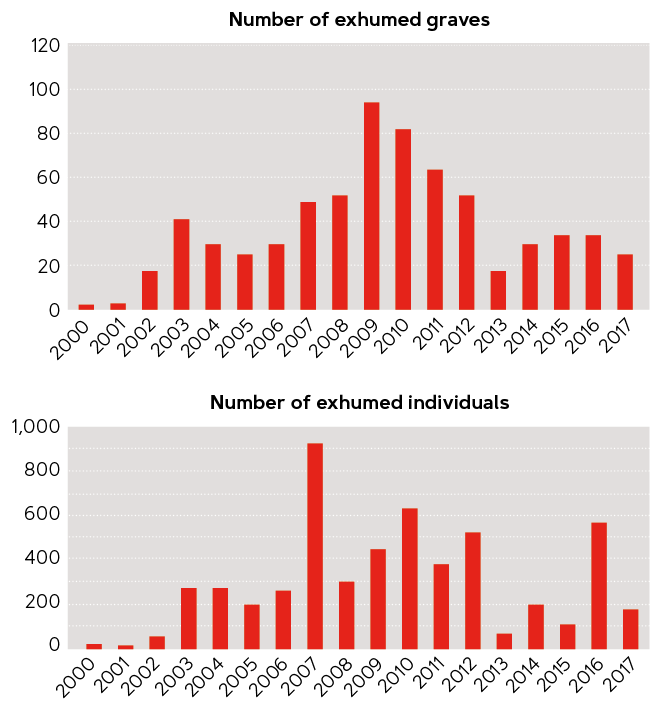
Figure 2. From the year 2000, there was a resurgence of historical memory in Spain. Even before the enactment of the so-called «Historical Memory Law» in 2007, several institutions and individuals had taken a stance regarding the need for legal regulation to investigate the consequences of Franco’s repression. The graph above shows the number of exhumed graves from the year 2000 to 2017; the graph below shows the number of individuals recovered in the same period. / Source: Francisco Etxeberria and Fernando Serrulla
There are at least three relevant events in recent history that have driven archaeology as applied to Civil War remains, both in mass graves and in scenarios related to the conflict, as well as others (Figure 2). First, a conference in March 2003 titled «La memoria de los olvidados. Un debate sobre el silencio de la represión en España» (“The memory of the forgotten. A debate on the silence of repression in Spain”) at the University of Valladolid, the proceedings of which were published under the same title (Etxeberria Gabilondo, 2003). This conference presented a methodological approach to exhumation following international criteria.
Second, the publication of a monograph in the journal Complutum in 2008 under the direction of Dr. Alfredo González Ruibal, titled Arqueología de la Guerra Civil (“Civil War archaeology”), which offers the foundations for the scientific interest and good intentions of these investigations, based on three points: archaeology, heritage, and policy about historic memory (González Ruibal, 2008).
Third, the 2012 publication of a monograph in Boletín Galego de Medicina Legal e Forense, presenting a synthesis of contemporary exhumations carried out in Spain as a consequence of recognising the victims of the Civil War and the subsequent dictatorship, which highlighted the essential role of forensic medicine in this matter as the discipline that can provide formal administrative and judicial level information about the truth (Etxeberria Gabilondo, 2012).
In 2007, Law 52/2007 of 26 December, was enacted. It recognised and extended rights and established measures in favour of those who were persecuted or suffered violence during the Civil War and the Dictatorship (Ley 52/2007, de 26 de diciembre; por la que se reconocen y amplían derechos y se establecen medidas en favor de quienes padecieron persecución o violencia durante la guerra civil y la dictadura, 2007), and is commonly known as the «Historical Memory Law». Before this law was enacted, several institutions and individuals had taken a stance about the need for legal regulation of these investigations.2 Regarding the location of graves and identification of remains, article 13 of this law states:
The competent public Administrations shall authorise prospecting tasks aimed at locating the remains of the victims referred to in article 11, section 1, in accordance with the regulations on historical heritage and the action protocol approved by the Government. The findings shall immediately be brought to the attention of the competent administrative and judicial authorities. (Law 52/2007, article 13, section 1)
Article 12 of the same law, regarding measures for the identification and location of victims, states the following:
The Government, in collaboration with all public Administrations, will prepare a protocol for scientific and multidisciplinary action to ensure institutional collaboration and adequate intervention in exhumations. (Law 52/2007, article 12, section 1)
At the same time, this article of the historical memory law also refers to grave location maps:
The competent public administrations shall prepare and make available to the interested parties referred to in article 13, within their respective territorial scope of action, maps showing the land on which the remains of the persons referred to in the previous article are located, including any supplementary information available on them.
«The development of forensic science is now also used in spaces such as human rights and humanitarian law»
The Government shall determine the procedure for the elaboration of an integrated map covering the entire Spanish territory, which shall be equally accessible to the interested parties and to which the data shall be incorporated which, under the terms established, shall be sent by the different competent public Administrations.
The areas included in the maps will be subject to special preservation by their owners, under the terms established by these regulations. (Law 52/2007, article 12, section 2)
This grave map was presented by the Government on 4 April 2011, although some autonomous communities refused to collaborate in its preparation, and so it still remains incomplete today.
Finally, and a long time later, the action protocol mentioned in Law 52/2007 was sanctioned by the Government on 26 September 2011 and is used as the guide which regulates exhumations and subsequent forensic analyses. Historical memory associations and other scientific institutions in the field of forensic anthropology were consulted in order to create the protocol. These consultations were carried out soon after the historical memory law was enacted but unfortunately, the document was not released until years later in 2011 (Orden PRE/2568/2011). This protocol moves a good part of the research competence to the field of forensic anthropology and pathology, within the general framework of forensic science.
Action protocol for exhumations
Hence, according to the published protocol (Orden PRE/2568/2011) the following research stages are established for an exhumation; first, preliminary investigations; second, archaeological intervention; third, forensic study of human remains; fourth, final report; and last, the inhumation of the remains into their final destination.
Whenever the state of the findings make it necessary, and when possible given the available means and circumstances, the team can include a physical anthropologist (expert in forensic anthropology), a forensic biologist (expert in genetics), a forensic pathologist (doctor specialising in forensic and legal medicine), and a forensic odontologist. A review of the technical reports generated according to the application of this protocol to varying extents tells us that to date, they have included the following sections: a historical report of the facts, a preliminary report on the grave, exploratory, exhumation, evidence, anthropological, genetic, victim, and other reports (e.g., ballistic reports, etc.).

Figure 3. In the picture, three brains found in the exhumation of the grave at La Pedraja (Burgos, Spain), performed in 2010. These brains underwent testing which provided the results we detail in this article. From top to bottom: A) bottom view of brain 11; B) left-side view of brain 25, and C) right-side view of brain 104. / Francisco Etxeberria and Fernando Serrulla
In short, following international recommendations, during exhumations the universal principles of criminology (International Forensic Strategic Alliance, 2014; UNODC, 2009) must be followed i.e., protection of the location, observation, preservation, evidence collection, delivery to the laboratory, and control of the chain of custody.
One specific and striking example is that of the brains preserved at the grave of La Pedraja
In the following we present some of the results from investigations carried out on the preserved brains of individuals 11, 25, and 104 (Figures 3a, 3b, and 3c) from among the 46 brains found at the La Pedraja site (Burgos, Spain). This grave (Figure 4) was excavated in August 2010 at the request of the Association of the Families of the People Murdered at the La Pedraja Mountains. The work was carried out by the Aranzadi Science Society in collaboration with several institutions (the Ministry of the Presidency, Association for the Recovery of Historical Memory, University of the Basque Country, Autonomous University of Madrid, and CSIC).
The grave was a homogeneous 24-metre-long trench whose width matched that of the victims’ height – who were each buried in parallel. The trench (Figures 5 and 6) was divided into two sections during the exhumation, grave 1 and grave 2 which were clearly separated by a segment of land with no inhumations. The excavation also identified other sections (A to F) used as independent successive graves as more bodies were buried. A natural crevasse was probably used to create the grave, because at that point in the slope, the grave maintains the line of maximum gradient. According to historical data, the location was used from July to November 1936 to bury the victims of murders from nearby villages in Burgos and La Rioja.
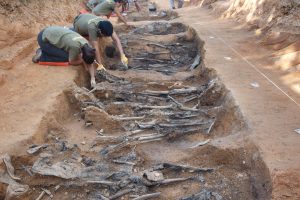
Figure 4. General aspect of the La Pedraja grave during the exhumation, which began in August 2010. According to historical data, the site was used from July to November 1936 to bury the victims of murders from nearby villages in Burgos and La Rioja. / Francisco Etxeberria and Fernando Serrulla
Brain preservation, maintenance techniques, and proposals
Three brains were kept in refrigerated plastic bags and containers from the place of burial to the sample analysis location, without suffering significant changes. Therefore, we can confirm that the preservation method for the brains was adequate for the time considered, based exclusively on the evaluation of their external appearance. The chosen method seems appropriate because it allows the maintenance of similar levels of humidity to the original location, thus minimising the proliferation of microorganisms thanks to the mean refrigerated temperature of around 4 °C). The 46 brains of La Pedraja are the best-preserved brain collection in the world (Serrulla et al., 2016); until just a year ago, it was also the largest collection but it was surpassed by the 104 brains found in the graves of the Cementerio del Carmen in Valladolid (Serrulla, García-Rubio, Martínez, Del Olmo, & Del Olmo, 2018).
Macroscopic aspects
The preservation of these brains is extraordinarily surprising. Their size had reduced by between a seventh and an eleventh of their volume but they had acceptably retained their external morphology. Brain 25 (Figure 3b) is particularly noteworthy because its convolutions still retain a waxy appearance, and many cerebellar convolutions have been preserved in a good state in brain 11 (Figure 3a).
Brain rehydration techniques
Prior to the study of the brains, we considered the possibility of using different rehydration techniques including Ruffer solution 1 (96 % alcohol, distilled water, and 5 % sodium carbonate) and others using glycerol and phosphate buffer. The results were similar in every case when we consider both the fact that the samples were not degraded during the hydration process and that we were able to carry out several stainings in every case, including immunohistochemical stainings. However, in our opinion, Ruffer solution 1 was the most useful because it requires a much shorter rehydration time and provides very similar overall results (Serrulla et al., 2016).

Figure 5. The grave of La Pedraja, with its different sections. According to the interpretation of the burials, these were performed from section 2F to section 1A. The studied brains presented in this article were found in the following locations: section 1B (brain 11), section 1C (brain 25), and section 2F (brain 104).

Figure 6. Distribution of the ammunition found in the La Pedraja grave: red dots indicate projectiles and green dots indicate shells.
Radiological study
The radiological study (Figure 7) also offered interesting results: it verified the different radiological density of each of the brains. None of them showed areas with intra-parenchymatous calcification. However, the radiological consistency of the three brains was very different and correlated with their weight. Although an increase in density in both frontal poles was detected in brain 11, the computed axial tomography (CAT) scan showed evidence that this increase may have been an artefact related to the presence of soil remains in the brain surface. The CAT scan also allowed the acquisition of DICOM (digital imaging and communication in medicine) images for modelling. The analysis of tomography images from these three brains allowed us to rule out the presence of masses or marked differences in density within the parenchyma, as well as bone or metallic elements. Of note, brain hydration made it possible to successfully perform nuclear magnetic resonance (NMR) scans while, in our experience, NMR is not useful when performed on non-rehydrated brains (Serrulla et al., 2016).
Brain modelling
The acquisition of DICOM images from these three brains allowed one of them to be modelled in polyresin by stereolithography (Figure 8). In our opinion, this modelling is very valuable because, unlike histopathological and toxicological studies which completely destroy the brain structure, it allows brain morphology to be preserved for educational and museographic purposes. In fact, some current 3D printing techniques use ceramic powder and can generate models with different textures and colours at lower costs than polyresin printers (Serrulla et al., 2017; Serrulla, Etxeberria, Herrasti, Cascallana, & Del Olmo, 2015; Serrulla, Herrasti, & Etxeberria, 2016).
Chemical and chemo-toxicological study
The chemo-toxicological study excluded the presence of intended toxins (drug abuse) and among others, identified stearamide and monounsaturated, polyunsaturated, and saturated fatty acids (oleic, linoleic, and ricinoleic acid, respectively). As many authors have stated, this fatty acid profile is characteristic of the saponification process (Algarra, Rodríguez-Borges, & Esteves da Silva, 2010). Through hydrolysis, the triglycerides in many human fatty tissues become fatty acids during the decomposition process. The hydrogenation of these fatty acids turns them into saturated fatty acids, which under certain conditions, forms adipocere. One of these fatty acids (lignoceric acid) is one of the main components of cerebrosides, a glycosphingolipid present in many cell membranes, as well as the central and peripheral nervous system because they form part of neuron myelin sheaths (Tower, 1994).
«The right to know the truth does not go out of date, it has no expiration date»
Almost half the dry weight of the encephalon in vertebrates is made of lipids and so, it contains approximately 25 % of our body’s total cholesterol (Tower, 1994). Sterols and stanols are common elements in cholesterol degradation, which are very important in microbiological terms, however, the fact that no sterols or stanols were detected in these brains was not particularly remarkable.
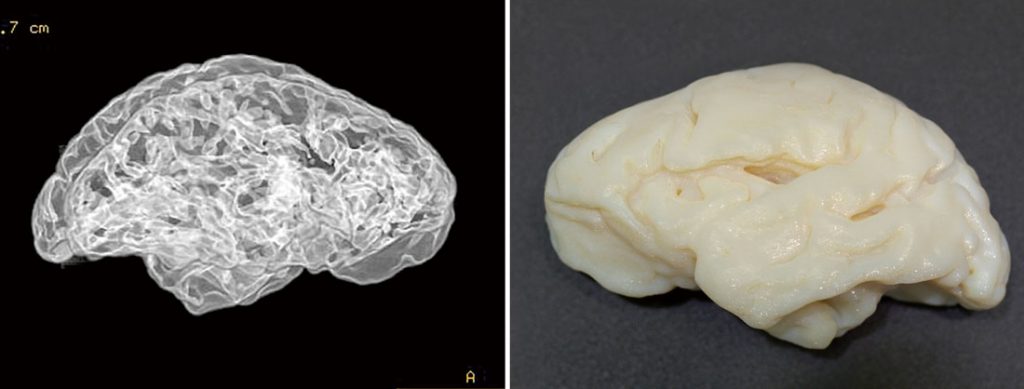
Figure 7 (left). 3D radiological recreation of brain 25 obtained via a computed axial tomography (CAT) scan. The radiological study of these brains allowed us to check the densities of each one and thus, discard the presence of masses or differences marked inside the parenchyma, as well as metallic or bony elements. / Francisco Etxeberria and Fernando Serrulla
Figure 8 (right). The radiological CAT study (Figure 7) provided digital images of the brain for modelling purposes. Thus, the image shows a model of brain 25 created by stereolithography using polyresin. This technique allows the morphology of the brain to be preserved for educational and museographic purposes because histopathological and toxicological studies completely destroy the brain structure. / Francisco Etxeberria and Fernando Serrulla
In these contexts, the chemical study of the soil is especially interesting and may be one of the key reasons why these brains were preserved. All of the soil samples we collected had special characteristics and were distinct from other Spanish Civil War graves we have studied. Most had acidic or very acidic pH values and low organic matter content together with relatively low levels of calcium. Experience dictates that this chemical profile usually corresponds to highly degraded skeletons, as in this case. However, we often also find low pH values correlated with high organic matter content (the characteristic soil type found in cemeteries where bodies are buried underground). This was not the case here: both the pH value and the organic matter content was low. If the pH remains low at different sampling points despite the absence of organic matter, we must deduce that the acidity is essentially due to characteristics inherent to the soil itself and that these would barely be affected by the decomposition of 104 bodies (Serrulla et al., 2016).
Histopathological studies
In general terms, we consider that the histopathological study was a success, although the experts with whom we collaborated in this work do not agree on this point (Serrulla et al., 2016), there was evidence of histologically provable neurological structures:
First, there was ultrastructural evidence of myelinated axon structures, as other authors have proven in similar cases.
Second, there was extensive histopathological evidence of the preservation of blood vessels, although some round and walled structures may better correspond to plant structures.
Third, there was an accumulation of rounded structures with a cerebellar cortex nuclei morphology in both cortical layers. It is possible that this was plant contamination, but given the morphology and location of the finding, it is striking enough to be considered within the hypothesis that these were the nuclei of cortical cerebellar cells.
«All of the soil samples from La Pedraja had special characteristics and were distinct from other Spanish Civil War graves»
Fourth, we also believe that there was sufficient data to support the hypothesis that brain 11 showed macro- and microscopic indications of the existence of a subarachnoid haemorrhage or an intra-parenchymatous haemorrhage. Neither of these would be strange, given the context of the violent homicidal deaths surrounding these human remains.
Last, the use of Prussian blue (Figure 9) clearly highlighted the presence of haemosiderin and, therefore, of a subarachnoid haemorrhage produced at least 48 hours before death. Thus, this finding provides evidence that brain preservation can open the door to research of abuse and torture even eighty years after the original events occurred (Serrulla, 2018; Serrulla et al., 2016).
Hypotheses about the mechanism of brain preservation
Considering all the above, we accept the following (Serrulla et al., 2017): first, the chemical composition of these brains corresponds to the usual pattern observed in many saponification processes or in the formation of adipocere. Although we do not know the amounts of each fatty acid found, qualitatively, these clearly coincide with the results of other similar work.
Second, all the brains in the grave were preserved; i.e., the brains of all the people buried there from July to November 1936. There is no precise record of the burial dates, but section 1D, which had the highest percentage of preserved brains, might have been used in autumn 1936.
Third, in geological terms, the grave contains sedimentary soil comprising clay, sand, and round stones. These were very compacted and were therefore quite impervious to water. The location is around 1,100 meters above sea level, located in a gentle mountain slope facing southwest in a natural fissure; this caused them to become basins full of rain and runoff water.
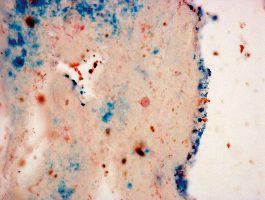
Figure 9. The image shows Prussian blue staining performed on brain 11. This test revealed the existence of a subarachnoid (marked in blue close to the border) and intra-parenchymatous (marked in blue in the interior) haemorrhage from at least 48 hours before death. This finding shows that brain conservation can be a gateway to investigate abuse and torture even eighty years after the original events occurred. / Francisco Etxeberria and Fernando Serrulla
Finally, no weather data is available for the specific grave location. However, we obtained meteorological data from the Burgos observatory (854 m altitude) about 30 km from the grave, as well as data from a meteorological observation point in Atapuerca (Burgos) at 966 m altitude and about 10 km from the grave. These confirmed that in Atapuerca, there was higher rainfall than usual (double) in June 1936 and that in October 1936, there was 50 % more rainfall than normal. The average summer temperatures were no different from usual, although the autumn temperatures were lower than usual.
In short, it appears that the beginning of the summer of 1936 was very rainy and the autumn was likely rainier and colder than usual. Thus, we consider it likely that the grave site – a natural drainage point for the La Pedraja mountain – was affected by a significant amount of rainwater between June and October 1936 and lower-than-usual temperatures in October 1936.
Conclusions
Our cumulative experience with over 500 mass graves exhumed since the year 2000 and the protocol implemented from 2011, make it possible to obtain evidence using forensic science resources originally developed specifically for forensic archaeology and forensic anthropology. In this specific case, we see how these disciplines helped us to clarify the events that occurred at the La Pedraja grave between July and November 1936: we were able to recover soft tissues which allowed us to identify some of the injuries suffered by the victims before they died, as well as to establish a hypothesis about the circumstances that favoured their preservation.
It would be advisable to improve current coordination and management systems and to create stable research teams in order to guarantee the successful delivery of results under the tutelage of administrative bodies who can, and must, validate these results.
Notes
1. See the ICRC press release from 10 December 2017 at https://www.icrc.org/en/document/falklandmalvinas-islands-icrc-presents-argentina-and-united-kingdom-results-humanitarian. (Go back)
2. For instance, the Spanish section of Amnesty International, with their report «Víctimas de la guerra civil y el franquismo: no hay derecho» (“Victims of the civil war and the Franco regime: there are no rights”). Retrieved from https://www.es.amnesty.org/uploads/media/No_hay_derecho.pdf). (Go back)
REFERENCES
Algarra, M., Rodríguez-Borges, J. E., & Esteves da Silva, J. C. (2010). LC-MS identification derivatized of free fatty acids from adipocere in soil samples. Journal Separation Sciences, 33(2), 143–154. doi: 10.1002/ jssc.200900614
CICR, & Instituto de Medicina Legal y Ciencias Forenses de Perú. (2017). Guía práctica para la recuperación y análisis de restos humanos en contextos de violaciones a los Derechos Humanos e infracciones contra el Derecho Internacional Humanitario. Retrieved from https://www.icrc. org/es/download/file/46302/informe_mp_final_final.pdf
Etxeberria Gabilondo, F. (2003). Panorama organizativo sobre antropología y patología forense en España. Algunas propuestas para el estudio de las fosas con restos humanos de la Guerra Civil Española de 1936. In E. Silva, P. Salvador, M. S. A. Esteban Recio, & J. Castán (Coords.), La memoria de los olvidados: Un debate sobre el silencio de la represión en España (pp. 183–219). Valladolid: Universidad de Valladolid.
Etxeberria Gabilondo, F. (Coord.). (2012). Antropología forense de la Guerra Civil Española. Boletin Galego de Medicina Legal e Forense, 18. Retrieved from http://www.agmf.es/boletin18.html
Ferrándiz, F. (2019). Unburials, generals, and phantom militarism engaging with the Spanish Civil War legacy. Current Anthropology, 60(S19), S62– S76. doi: 10.1086/701057
González Ruibal, A. (2008). Arqueología de la Guerra Civil Española. Complutum, 19(2), 11–20.
Instituto Nacional de Medicina Legal y Ciencias Forenses de Colombia. (2017). Estándares forenses mínimos para la búsqueda de personas desaparecidas y la recuperación e identificación de cadáveres. Retrieved from https://www.alafforense.org/estandar.html
International Forensic Strategic Alliance. (2014). Requisitos mínimos para investigación de la escena del crimen. Retrieved from http://www.ifsa-forensics.org/wp-content/uploads/2017/10/IFSA-CSI-MRD-Spanish.pdf
Ley 52/2007, de 26 de diciembre, por la que se reconocen y amplían derechos y se establecen medidas en favor de quienes padecieron persecución o violencia durante la guerra civil y la dictadura. (2007). Retrieved from https://www.boe.es/eli/es/l/2007/12/26/52/con
Orden PRE/2568/2011, de 26 de septiembre, por la que se publica el Acuerdo del Consejo de Ministros de 23 de septiembre de 2011, por el que se ordena la publicación en el Boletín Oficial del Estado del Protocolo de actuación en exhumaciones de víctimas de la Guerra Civil y la dictadura. (2011). Retrieved from https://www.boe.es/eli/es/o/2011/09/26/pre2568
Serrulla, F. (Coord.). (2013). Recomendaciones en antropología forense. Verín: Asociación Española de Antropología y Odontología Forense. Consultado en http://aeaof.com/index.html#libros-pdfs
Serrulla, F. (2018). Antropología forense de la Guerra Civil Española. Tesis Doctoral. Granada: Universidad de Granada.
Serrulla, F., Etxeberria, F., Herrasti, L., Cascallana, J. L., & Del Olmo, J. (2017). Saponified brains of the Spanish Civil War. In E. Shotsmans, N. Márquez-Grant, & S. L. Forbes (Eds.), Taphonomy of human remains. Forensic analysis of the dead and depositional environmental (pp. 429–437). Chichester, West Sussex, Hoboken, NJ: Wiley.
Serrulla, F., García-Rubio, A., Martínez, B., Del Olmo, J., & Del Olmo, L. (2018). Estudio antropológico forense de las fosas del Cementerio del Carmen de Valladolid. Resultados preliminares. En Actas de la IX Reunión Nacional de la Asociación Española de Antropología y Odontología Forense. Palma de Mallorca: AEAOF.
Serrulla, F., Herrasti, L., & Etxeberria, F. (2015). Corazón preservado 70 años por saponificación. Revista Española de Medicina Legal, 41(1), 43– 44. doi: 10.1016/j.reml.2014.07.001
Serrulla, F., Herrasti, L., Navarro, C., Cascallana, J. L., Bermejo, A. M., Márquez-Grant, N., & Etxeberria, F. (2016). Preserved brains the Spanish Civil War mass grave (1936) at La Pedraja 1, Burgos, Spain. Science and Justice, 56(6), 453–463. doi: 10.1016/j.scijus.2016.08.001
Tower, D. B. (1994). Brain chemistry and the French connection, 1791-1841: An account of the chemical analyses of the human brain by Thouret (1791), Fourcroy (1793), Vauquelin (1811), Couerbe (1834), and Frémy (1841): A second sourcebook in the history of neurochemistry. New York: Raven Press.
UNODC. (2009). Crime scene and physical evidence awareness for non-forensic personnel. Viena: United Nations Office on Drug and Crime. Retrieved from https://www.unodc.org/documents/scientific/Crime_scene_ awareness__Ebook.pdf

